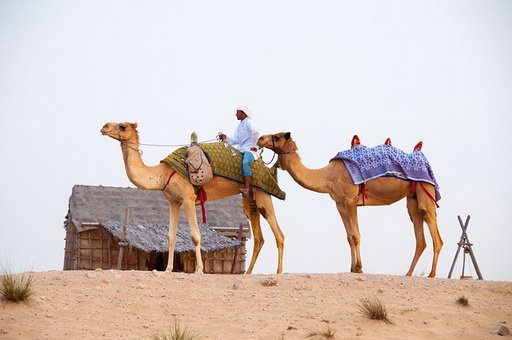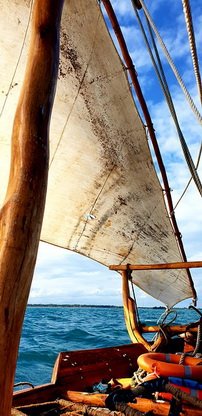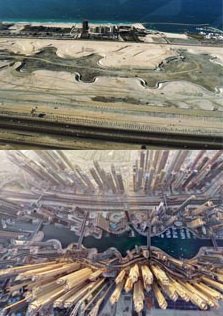„What is good for the merchants is good for Dubai” by Sheikh Rashid
E
very good story started somewhere and since they happened in the past, we call them history. A place and its people are the sum of all the experiences of the previous generations. Dubai is a bright example of that!
As usual, I will try not to bore you with details, but some things must be told to better understand the culture you want to visit.
Is it important to tell you that the Arab Peninsula was once green? Maybe not but it is quite fun to think of a tropical jungle being in the Empty Quarter. Today nothing lives there but in 3000 BC there were elephants! Today the desert is at the borders of the city as if threatening to swallow it like it once did. Think about it if you are planning a trip to the golden dunes – not every time they are this close.
With the sands of old came the Nomads – the only people able to live in the new, harsh conditions. Some settlements were created in specific places. But for centuries those specifications were always the same – trade and war. All the great civilizations of this area (Achaemenid, Sassanid, Umayyad Empires) wanted to control some trade routes leading along the shore into the Persian Gulf or they had a trading settlement in the region. There was no other reason to live here and the major cities like Mekka or Damascus were further North.
Knowledge is scarce. There was a mention of Dubai and the pearl industry in the XI century. Then, in the same subject, a Venetian merchant wrote about his brethren living there in the XVI century. All this time trade, delicate military balance, and numerous cultures mixed up together.
It was unavoidable then. Sailors depended on the seasonal monsoon winds and sometimes they had to stay longer in one place. This simple thing created the local multitude of cultures.
The British came around the XIX century, passing the Peninsula on their road to India. They learned about the difficulties of the region – self-governed cities and raids from Nomads among others. They named the coast where Dubai is situated The Pirate Coast! Their military power made Arabs listen… but only until the moment that they retaliated and took what was theirs.
This is the moment when Dubai of today starts to exist.
The area was governed by tribes (like Scottish clans) who had their own problems. In a political feud, the tribe of the Beni Yas leaves Abu Dhabi (one of the greatest cities of the region) and settles further North. The place has few houses then and is living in pearl diving. Maktoum bin Butti turns it into Dubai in 1833 and Al Fahidi Fort is created – the beginnings of a city.
The British have a difficult time in the Arab Peninsula. They decide to sign a treaty with the coastal cities. The idea is to end the piracy that disrupts their trade. They didn’t like the slave trade either, so a point was added. From their side, they offered help, or else…. The proof that the treaty was forced may be the continued pirate presence. When the British promised not to intervene in the internal and administrative affairs of the Arabs in 1853, everything stopped.
Dubai’s Al Maktoum Dynasty exploited the treaty to its full length. Their secret was “good relations”, especially with the Europeans. Through careful negotiations, they managed to become a British protectorate. They also created the first tax-free zone. That was the bull’s eye – they started to import on a massive scale and then immediately re-export. The Sheikh even made a British ship named Dubai as its port of call. All of this together and the pearl industry made the city grow rapidly.
Profits returned mostly to the state, but the Sheikh was a man with a vision. He invested in the city, creating the infrastructure for more trade and future possibilities. His successor Sheikh Saeed bin Maktoum continued this policy. Today we can say that the administration, transport, and many organizations belong to the Sheikh too. It creates unification and peace of mind for “small” people. And many profits for the state as well. It was like that and is still – a lot is reinvested back into the city.
Dubai of the beginnings of 1900 was so ingenious that it became a magnet. Persians came to settle in a place they called Bastakiya. They traded at the Dubai Creek taking profits from the tax-free possibility. Soon, 1/3 of the city’s population was foreign.
Saeed II bin Maktoum’s vision started in the 1960s.
At the start, he was riding on a wave created by his father. But soon the Great Depression of 1929 hit him – the creation of the artificial pearls. One pillar of Dubai collapsed. Something had to be done but the revolts came first. The sheik had to do something with his internal problems.
Nomad tribes of the Bedouins helped, giving proof of the successful political relations of the Maktoums. Another one was the British buffer zone between Dubai and Abu Dhabi – relations between the two cities were very difficult. Their constant quarrel wasn’t good for any of them. It was only thanks to the external influence of the Europeans that they ceased.
The light came in times of the new Sheikh – Rashid bin Saeed Al Maktoum (from 1958). Crude oil was found near the shore and another possibility opened. Dubai Creek was dredged to ameliorate the travel of all ships, no matter their size. New free zones were created, attracting new traders and businesses (Jebel Ali Free Zone).
Most of all the British announced they leave the area. They gave the Arabs some time to organize themselves. The warrior, hot-tempered, nomad blood flowed strongly in the people of the future UAE and many historical events had to be forgotten. But once the merchants were the nation of the Peninsula and this past ran in their blood as well. Their common goal united them and a treaty creating the United Arab Emirates was signed in Dubai in 1971. Of course, as in the past, Abu Dhabi had the most to tell in the matter of UAE destiny, but Dubai agreed to sign only if it became equal with his former enemy. Today they both have the most to say and they are the only Emirates that have the right of the veto in the Federal National Council. Branches of Beni Yas tribes were divided, but they finally came together again.
With each Sheikh Dubai was fighting for its identity and future. Great men with impossible visions created the city. Now there are more pillars that hold its economy – oil of course (although it is said to finish in 2028), trade, tourism, real estate are the main ones. Dubai deals with everything that is “the best”. “Good relations with everyone” policy attracts all kinds of people and companies, different nations, businesses, press companies, IT businesses (they have their own free zone), and many more. Their building projects are impressive, and many things can be created in Dubai only because the Sheikh agrees with the project.
The city is proof of the power of an idea. It also took its lesson from the past – more pillars! What is more – it is advancing into the future with a project that will turn Dubai into the first city of the new era (alternative power instead of oils).
Worth-while links:
- a great comparison of the old and new Dubai can be found here. Remember to use the slider and move it left and right. I recommend taking a look
- projects in plans and being built in Dubai (like the museum of the future or Royal Atlantis Hotel or the Dubai Creek Tower – soon to be over 1300 metres high) – one of many you tube videos here; and an article here
- many thanks to the resources of the Arabian Gulf Digital Archive (Sheikhs photos and background knowledge)







